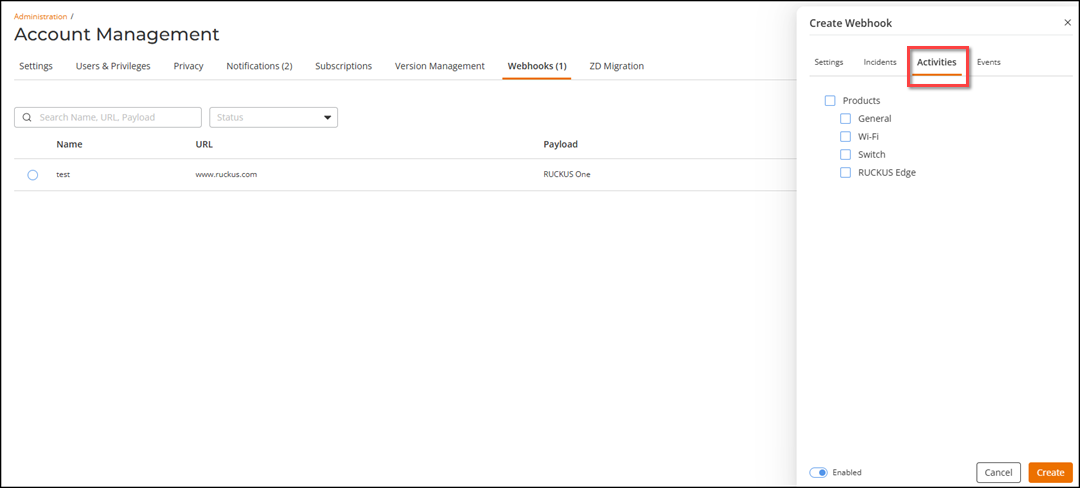Setting Up Webhooks in RUCKUS One
RUCKUS One allows you set up Webhook URLs for real-time incident notifications, similar to email alerts, using messages or payloads to share incident details between applications.
-
From the RUCKUS One web
interface, select Administration > Account
Management > Webhooks.
The Account Management page, Webhooks tab is displayed.
The Webhooks page displays all the created webhooks in a table.
The webhooks table has the following attributes:- Name: Displays the name of the webhook.
- URL: Enter the webhook URL created by appending the domain URL and the base API path from the other application.
- Payload: Displays the payload or messaging service configured for the webhook. Options include RUCKUS One, DataDog, Microsoft Teams, PagerDuty, Service Now, Slack, and Splunk.
- Status: Displays whether the webhook is Enabled or Disabled.
Webhook Tab 
Under each attribute is a search field to limit the webhooks list based on the search criteria.
Select a webhook and click Edit to edit the webhooks information and click Delete to delete the webhooks.
You can select the number of webhooks displayed in the table from the Show rows drop down at the bottom of the table. The range is from five webhooks per table to 100 webhooks per table.
-
Click Create Webhook to
set attributes for the webhook.
The Settings tab has the following options:
- Name: Enter the name of the webhook.
- Webhook URL: Enter the URL.
- Secret: Enter the secret key generated for authentication from the service record.
- Payload: Select a payload tool from the drop-down menu that you can configure to notify RUCKUS One when an alert is triggered.
Table 1. Configuring the Webhook URL in Different Platforms Tool Reference to Create Incoming Webhook Microsoft Teams https://learn.microsoft.com/en-us/microsoftteams/platform/webhooks-and-connectors/how-to/add-incoming-webhook?tabs=newteams%2Cdotnet Webhook URL Example:
https://commscope.webhook.office.com/webhookb2/9ee5a30e-38f5-4d17-8bb7-1c4af721b2fe@31471f81-8fe4-49ec-8bc3-fa1c295640d7/IncomingWebhook/30dbf8413ea2421890d1a5d1e45481b4/e36aca5e-5c9e-4549-9a29-761977b3798a/V2wg7zMjjRZmGM3DTJB2rQ9A5ynttxrH1qJOaxzjUyn141Slack https://api.slack.com/messaging/webhooks Webhook URL Example:
https://hooks.slack.com/services/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Splunk https://docs.splunk.com/Documentation/SplunkCloud/9.3.2408/Data/UsetheHTTPEventCollector#Configure_HTTP_Event_Collector_on_Splunk_Cloud_Platform Webhook URL Example:
https://${splunk cloud instance hostname}:8088/services/collector/eventWebhook Secret for Authentication: ${token value}
DataDog https://us5.datadoghq.com/account/login?next=%2Fevent%2Fexplorer%3Fcols%3D%26messageDisplay%3Dexpanded-lg%26options%3D%26refresh_mode%3Dsliding%26sort%3Ddesc%26view%3Dall%26from_ts%3D1737065073528%26to_ts%3D1737065973528%26live%3Dtrue Webhook URL Example:
https://${Datadog cloud instance hostname}/api/v1/eventsWebhook Secret for Authentication: ${API KEY}
PagerDuty https://identity.pagerduty.com/global/authn/authentication/PagerDutyGlobalLogin/subdomain Webhook URL Example:
https://events.pagerduty.com/v2/change/enqueueWebhook Secret for Authentication: ${Integration Key}
Webhooks - Settings Tab  The Incidents tab has the following options:
The Incidents tab has the following options:- Severity: Select one or more incident severities, ranging from P1 (highest priority incident) to P4 (lowest priority incident), for which you want to receive notifications.
Webhooks - Incidents Tab  The Activities tab has the following options:
The Activities tab has the following options:- Products: Select the product types for which you want to receive notifications, such as General, Wi-Fi, Switch, or RUCKUS Edge.
Webhooks - Activities Tab  The Events tab has the following options:
The Events tab has the following options:- Severity: Select the event severities for which you want to receive notifications, such as Critical, Major, Minor, Warning, or Informational.
- Event Types: Select the event types for which you want to receive notifications, such as AP, Security, Client, Switch, Admin, Network, RUCKUS Edge, or Profile.
- Products: Select the product types for which you want to receive notifications, such as General, Wi-Fi, Switch, or RUCKUS Edge.
Webhooks - Events Tab 
-
Click the toggle at the bottom of the sidebar to Enable or
Disable the webhook. If webhook URL is enabled, the messaging service
(such as ServiceNow and Slack) will receive notifications about the incidents.
Note: You must select at least one Incident, Activity, or Event prior before you can enable the webhook
- Click Create. The new webhook is created and listed in the Administration > Account Management > Webhooks tab.